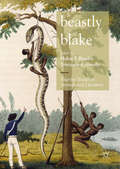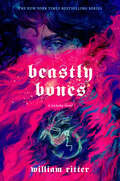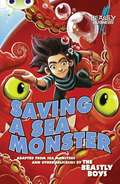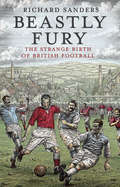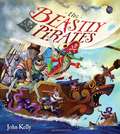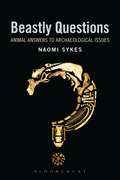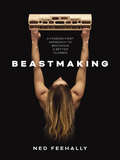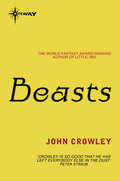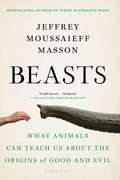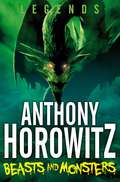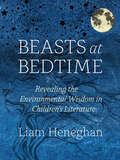- Table View
- List View
Beastly Blake (Palgrave Studies in Animals and Literature)
by Helen P. Bruder Tristanne ConnollyBlake’s ‘Human Form Divine’ has long commanded the spotlight. Beastly Blake shifts focus to the non-human creatures who populate Blake’s poetry and designs. The author of ‘The Tyger’ and ‘The Lamb’ was equally struck by the ‘beastliness’ and the beauty of the animal kingdom, the utter otherness of animal subjectivity and the meaningful relationships between humans and other creatures. ‘Conversing with the Animal forms of wisdom night & day’, Blake fathomed how much they have to teach us about creation and eternity. This collection ranges from real animals in Blake’s surroundings, to symbolic creatures in his mythology, to animal presences in his illustrations of Virgil, Dante, Hayley, and Stedman. It makes a third to follow Queer Blake and Sexy Blake in irreverently illuminating blind spots in Blake criticism. Beastly Blake will reward lovers of Blake’s writing and visual art, as well as those interested in Romanticism and animal studies.
Beastly Blake (Palgrave Studies in Animals and Literature)
by Helen P. Bruder Tristanne ConnollyBlake’s ‘Human Form Divine’ has long commanded the spotlight. Beastly Blake shifts focus to the non-human creatures who populate Blake’s poetry and designs. The author of ‘The Tyger’ and ‘The Lamb’ was equally struck by the ‘beastliness’ and the beauty of the animal kingdom, the utter otherness of animal subjectivity and the meaningful relationships between humans and other creatures. ‘Conversing with the Animal forms of wisdom night & day’, Blake fathomed how much they have to teach us about creation and eternity. This collection ranges from real animals in Blake’s surroundings, to symbolic creatures in his mythology, to animal presences in his illustrations of Virgil, Dante, Hayley, and Stedman. It makes a third to follow Queer Blake and Sexy Blake in irreverently illuminating blind spots in Blake criticism. Beastly Blake will reward lovers of Blake’s writing and visual art, as well as those interested in Romanticism and animal studies.
Beastly Bones: A Jackaby Novel (Jackaby #2)
by William RitterIn this highly anticipated sequel, Abigail and Sherlockian detective of the supernatural Jackaby follow a trail of mysterious deaths from New Fiddleham to nearby Gad's Valley. There they are reunited with exiled police detective Charlie Cane, and the three race to find the culprit before more lives are lost.
The Beastly Bunch
by Leisa Stewart-SharpeFlamingo Flo is throwing the most FABULOUS, most PERFECT pool party. And her spitty, smelly, bitey neighbours the Beastly Bunch are definitely NOT invited. But when Flo's true colours shine through, her guests leave and her perfect party is . . . a flop. Will Flo realise what friendship is REALLY all about before it's too late?The Beastly Bunch is a fun, riotous picture book that celebrates the importance of kindness and inclusivity - and reminds us that being fabulous is all about how you feel and how you treat others, NOT how you look!
Beastly Business, Blue B, 4A: Saving a Sea Monster (PDF)
by The Beastly BoysA sea monster at the RSPCB is dying. The only way it can survive is for Dr Fielding to perform an operation on its brain ... but she can't get close to the monster as it has a massive stinger full of deadly venom! Can Ulf remove the monster's deadly venom without being stung?
Beastly encounters of the Raj: Livelihoods, livestock and veterinary health in North India, 1790–1920 (Studies in Imperialism)
by Saurabh MishraThis is the first full-length monograph to examine the history of colonial medicine in India from the perspective of veterinary health. The history of human health in the subcontinent has received a fair amount of attention in the last few decades, but nearly all existing texts have completely ignored the question of animal health. This book will not only fill this gap, but also provide fresh perspectives and insights that might challenge existing arguments. At the same time, this volume is a social history of cattle in India. Keeping the question of livestock at the centre, it explores a range of themes such as famines, agrarian relations, urbanisation, middle-class attitudes, caste formations etc. The overall aim is to integrate medical history with social history in a way that has not often been attempted.
Beastly Fury: The Strange Birth Of British Football
by Richard Sanders"Footeballe is nothinge but beastlie furie and extreme violence", wrote Thomas Elyot in 1531. Nearly five hundred years later, the game may still seem furious and violent, but it has also become the most popular sport on the planet.This is the story of how the modern, professional, spectator sport of football was born in Britain in the second half of the nineteenth century. It's a tale of testosterone-filled public schoolboys, eccentric mill-owners and bolshy miners, and of why we play football the way we do. Who invented heading? Why do we have an offside law? And why are foreigners so much better than us at the game we invented?Based on exhaustive research, Beastly Fury picks apart the complex processes which forged the modern game, turning accepted wisdom on its head. It's a story which is strangely familiar - of grasping players, corrupt clubs and autocratic officials. It's a tale of brutality, but at times too, of surprising artistry. Above all it's a story of how football, uniquely among the sports of that era, became what it is today - the people's game.
Beastly Journeys: Travel and Transformation at the fin de siècle (Liverpool English Texts and Studies #63)
by Tim YoungsAn Open Access edition of this book is available on the Liverpool University Press website and the OAPEN library.Bats, beetles, wolves, butterflies, bulls, panthers, apes, leopards and spiders are among the countless creatures that crowd the pages of literature of the late nineteenth century. Whether in Gothic novels, science fiction, fantasy, fairy tales, journalism, political discourse, realism or naturalism, the line between the human and the animal becomes blurred. Beastly Journeys examines these bestial transformations across a range of well-known and less familiar texts and shows how they are provoked not only by the mutations of Darwinism but by social and economic shifts that have been lost in retellings and readings of them. The physical alterations described by George Gissing, George MacDonald, Arthur Machen, Arthur Morrison, W.T. Stead, Bram Stoker, H.G. Wells, Oscar Wilde, and many of their contemporaries, are responses to changes in the social body as Britain underwent a series of social and economic crises. Metaphors of travel – social, spatial, temporal, mythical and psychological – keep these stories on the move, confusing literary genres along with the indeterminacy of physical shape that they relate. Beastly Journeys will appeal to anyone interested in the relationship between nineteenth-century literature and its contexts and especially to those interested in the fin de siècle and in metaphors of travel, animals and shape-changing.
The Beastly Pirates
by John KellyFantastic animated eBook edition wonderfully read by Lenny Henry!They're called The Beastly Piratesand this fearsome ugly bunchscour the seas for other piratesthey can gobble up for lunch.Beware THE BEASTLY PIRATES – the scariest sailors on the seven seas.They're a cutlass-toting, pirate-eating bunch of renegades and the list of their dastardly deeds is endless. Dare you come to face to face with this motley crew? WARNING: This is most certainly NOT a book for bedtime . . . unless you like your pirates with a bit more bite! Perfect for fans of Jonny Duddle.Please note that audio is not supported by all devices. Please consult your manual for confirmation.
Beastly Questions: Animal Answers to Archaeological Issues
by Naomi SykesZooarchaeology, or the study of ancient animals, is a frequently side-lined subject in archaeology. This is bizarre given that the archaeological record is composed largely of debris from human–animal relationships (be they in the form of animal bones, individual artifacts or entire landscapes) and that many disciplines, including anthropology, sociology, and geography, recognise human–animal interactions as a key source of information for understanding cultural ideology. By integrating knowledge from archaeological remains with evidence from texts, iconography, social anthropology and cultural geography, Beastly Questions: Animal Answers to Archaeological Issues seeks to encourage archaeological students, researchers and those working in the commercial sector to offer more engaging interpretations of the evidence at their disposal. Going beyond the simple confines of 'what people ate', this accessible but in-depth study covers a variety of high-profile topics in European archaeology and provides novel interpretations of mainstream archaeological questions. This includes cultural responses to wild animals, the domestication of animals and its implications on human daily practice, experience and ideology, the transportation of species and the value of incorporating animals into landscape research, the importance of the study of foodways for understanding past societies and how animal studies can help us to comprehend issues of human identity and ideology: past, present and future.
Beastly Questions: Animal Answers to Archaeological Issues
by Naomi SykesZooarchaeology, or the study of ancient animals, is a frequently side-lined subject in archaeology. This is bizarre given that the archaeological record is composed largely of debris from human–animal relationships (be they in the form of animal bones, individual artifacts or entire landscapes) and that many disciplines, including anthropology, sociology, and geography, recognise human–animal interactions as a key source of information for understanding cultural ideology. By integrating knowledge from archaeological remains with evidence from texts, iconography, social anthropology and cultural geography, Beastly Questions: Animal Answers to Archaeological Issues seeks to encourage archaeological students, researchers and those working in the commercial sector to offer more engaging interpretations of the evidence at their disposal. Going beyond the simple confines of 'what people ate', this accessible but in-depth study covers a variety of high-profile topics in European archaeology and provides novel interpretations of mainstream archaeological questions. This includes cultural responses to wild animals, the domestication of animals and its implications on human daily practice, experience and ideology, the transportation of species and the value of incorporating animals into landscape research, the importance of the study of foodways for understanding past societies and how animal studies can help us to comprehend issues of human identity and ideology: past, present and future.
Beastly Things: (Brunetti 21) (Brunetti #21)
by Donna LeonWhen a body is found floating in a canal, strangely disfigured and with multiple stab wounds, Commissario Brunetti is called to investigate and is convinced he recognises the man from somewhere. However, with no identification except for the distinctive shoes the man was wearing, and no reports of people missing from the Venice area, the case cannot progress.Brunetti soon realises why he remembers the dead man, and asks Signorina Elettra if she can help him find footage of a farmers' protest the previous autumn. But what was his involvement with the protest, and what does it have to do with his murder? Acting on the fragile lead, Brunetti and Ispettore Vianello set out to uncover the man's identity. Their investigation eventually takes them to a slaughterhouse on the mainland, where they discover the origin of the crime, and the world of blackmail and corruption that surrounds it. Both a gripping case and a harrowing exploration of the dark side of Italy's meat industry, Donna Leon's latest novel is a compelling addition to the Brunetti series.
Beastmaking: A fingers-first approach to becoming a better climber
by Ned Feehally‘When it comes to training for climbing, you are your own experiment.’Beastmaking by Ned Feehally is a book about training for climbing. It is designed to provide normal people – like you and me – with the tools we need to get the most out of our climbing.It is written by one of the world’s top climbers and a co-founder of Beastmaker. It features sections on finger strength, fingerboarding, board training, mobility and core, and includes suggested exercises and workouts. There are insights from some of the world’s top climbers, including Alex Honnold, Shauna Coxsey, Adam Ondra, Alex Puccio and Tomoa Narasaki.Free from jargon, it is intended to provide enough information for us to work out what we need to train, and to help us to train it.
Beasts (Gollancz S. F. Ser. #Vol. 20)
by John CrowleyPainter is a leo - part man, part lion - the result of one of man's genetic experiments, a powerful, beautiful, enigmatic creature deemed a 'failure' to be be hunted down. But Painter has two advantages in this world of small bickering nation states and political accommodation and compromise: his own strength and integrity, and the guile of Reynard, another of man's experiments, a subtle and potent intriguer, a king-maker . . .
Beasts: What Animals Can Teach Us About Human Nature
by Jeffrey Moussaieff MassonOrcas (or killer whales) are one of the planet's supreme predators. Alongside humans, they have the most complex brains to be found in nature. But while one of these two species has killed 200 million members of its own kind in the twentieth century alone, the other has killed none. This is where Jeffrey Masson's fascinating new book begins: there is something different about humans. Masson has shown us that animals can teach us much about our own emotions – about love (dogs), contentment (cats) and grief (elephants). But they have much to teach us about the negative emotions such as anger and aggression as well, and in unexpected ways. In Beasts he demonstrates that the violence we perceive in the 'wild' is mostly a matter of projection. We link the basest human behaviour to animals, to 'beasts', and claim the high ground for our species. We are least 'human', we think, when we succumb to our primitive, animal instincts. In fact, nothing could be further from the truth. Animal predators kill to survive, but there is nothing in the annals of animal aggression remotely equivalent to the violence mankind has inflicted upon itself. Humans, and humans in our modern industrialised world in particular, are the most violent species in existence. We lack what all other animals have: a check on aggression that serves the species rather than destroys it. And it is here that animals have something vitally important to teach us about ourselves.
Beasts: What Animals Can Teach Us About the Origins of Good and Evil
by Jeffrey Moussaieff MassonBestselling author Jeffrey Masson shows us what the animals at the top of the food chain-orca whales, big cats, etc.-can teach us about the origins of good and evil in ourselves.In his previous bestsellers, Masson has showed us that animals can teach us much about our own emotions-love (dogs), contentment (cats), and grief (elephants), among others. In Beasts, he demonstrates that the violence we perceive in the "wild†? is a matter of projection. Animals predators kill to survive, but animal aggression is not even remotely equivalent to the violence of mankind. Humans are the most violent animals to our own kind in existence. We lack what all other animals have: a check on the aggression that would destroy the species rather than serve it. In Beasts, Masson brings to life the richness of the animal world and strips away our misconceptions of the creatures we fear, offering a powerful and compelling look at our uniquely human propensity toward aggression.
Beasts and Beauty: Dangerous Tales
by null Soman ChainaniYou think you know these stories, don’t you? You are wrong. You don’t know them at all. Twelve tales, twelve dangerous tales of mystery, magic, and rebellious hearts. Each twists like a spindle to reveal truths full of warning and triumph, truths that free hearts long kept tame, truths that explore life . . . and death. A prince has a surprising awakening . . . A beauty fights like a beast . . . A boy refuses to become prey . . . A path to happiness is lost . . . then found again. New York Times bestselling author Soman Chainani respins old stories into fresh fairy tales for a new era and creates a world like no other. These stories know you. They understand you. They reflect you. They are tales for our times. So read on, if you dare.
Beasts and Gods: How Democracy Changed Its Meaning and Lost Its Purpose
by Roslyn FullerDemocracy does not deliver on the things we have assumed are its natural outcomes. This, coupled with a growing sense of malaise in both new and established democracies forms the basis to the assertion made by some, that these are not democracies at all.Through considerable, impressive empirical analysis of a variety of voting methods, across twenty different nations, Roslyn Fuller presents the data that makes this contention indisputable. Proving that the party which forms the government rarely receives the majority of the popular vote, that electoral systems regularly produce manufactured majorities and that the better funded side invariably wins such contests in both elections and referenda, Fuller's findings challenge the most fundamental elements of both national politics and broader society. Beast and Gods argues for a return to democracy as perceived by the ancient Athenians. Boldly arguing for the necessity of the Aristotelian assumption that citizens are agents whose wishes and aims can be attained through participation in politics, and through an examination of what “goods” are provided by democracy, Fuller offers a powerful challenge to the contemporary liberal view that there are no "goods" in politics, only individual citizens seeking to fulfil their particular interests.
Beasts and Gods: How Democracy Changed Its Meaning and Lost Its Purpose
by Roslyn FullerDemocracy does not deliver on the things we have assumed are its natural outcomes. This, coupled with a growing sense of malaise in both new and established democracies forms the basis to the assertion made by some, that these are not democracies at all.Through considerable, impressive empirical analysis of a variety of voting methods, across twenty different nations, Roslyn Fuller presents the data that makes this contention indisputable. Proving that the party which forms the government rarely receives the majority of the popular vote, that electoral systems regularly produce manufactured majorities and that the better funded side invariably wins such contests in both elections and referenda, Fuller's findings challenge the most fundamental elements of both national politics and broader society. Beast and Gods argues for a return to democracy as perceived by the ancient Athenians. Boldly arguing for the necessity of the Aristotelian assumption that citizens are agents whose wishes and aims can be attained through participation in politics, and through an examination of what “goods” are provided by democracy, Fuller offers a powerful challenge to the contemporary liberal view that there are no "goods" in politics, only individual citizens seeking to fulfil their particular interests.
Beasts and Monsters (Legends #1)
by Anthony HorowitzA collection of five bite-size myths from across the globe, Beasts and Monsters by bestselling author Anthony Horowitz tells the thrilling tales of some of the most terrifying beasts from the world of legend.Part of the Legends series of six books, Beasts and Monsters features the stories of fearless heroes and monstrous beasts, including Saint George and the Dragon and Perseus and the gruesome snake-headed gorgon Medusa.Featuring black and white illustrations, the Legends series by Anthony Horowitz, the author of the phenomenally successful Alex Rider series, brings classic stories to life with thrilling imagination.
Beasts and Monsters: Ultimate 20: Beasts And Monsters (EDGE: Ultimate 20 #4)
by Tracey TurnerTake the Ultimate 20 monster challenge! Highly collectable series that uses a card-game-based design to allow readers to compete against each other in a fact face-off with an ultimate line up of the best-of-the-best. Flick through the book, choose one of your Ultimate 20, then challenge your friends. Flick. Choose. Challenge.Inside you'll find these critters:Yeti, Sphinx, Basilisk, Werewolf, Centaur, Bunyip, Kelpie, The Chimera, Chupacabras,Kraken, Gorgon, Dragon, Hydra, Unicorn, Loch Ness Monster, Cyclops, Mongolian Death Worm,Mothman, Phoenix, Mokele Mbembe
Beasts at Bedtime: Revealing the Environmental Wisdom in Children’s Literature
by Liam HeneghanTalking lions, philosophical bears, very hungry caterpillars, wise spiders, altruistic trees, companionable moles, urbane elephants: this is the magnificent menagerie that delights our children at bedtime. Within the entertaining pages of many children’s books, however, also lie profound teachings about the natural world that can help children develop an educated and engaged appreciation of the dynamic environment they inhabit. In Beasts at Bedtime, scientist (and father) Liam Heneghan examines the environmental underpinnings of children’s stories. From Beatrix Potter to Harry Potter, Heneghan unearths the universal insights into our inextricable relationship with nature that underlie so many classic children’s stories. Some of the largest environmental challenges in coming years—from climate instability, the extinction crisis, freshwater depletion, and deforestation—are likely to become even more severe as this generation of children grows up. Though today’s young readers will bear the brunt of these environmental calamities, they will also be able to contribute to environmental solutions if prepared properly. And all it takes is an attentive eye: Heneghan shows how the nature curriculum is already embedded in bedtime stories, from the earliest board books like The Rainbow Fish to contemporary young adult classics like The Hunger Games. Beasts at Bedtime is an awakening to the vital environmental education children’s stories can provide—from the misadventures of The Runaway Bunny to more overt tales like The Lorax. Heneghan serves as our guide, drawing richly upon his own adolescent and parental experiences, as well as his travels in landscapes both experienced and imagined. Organized into thematic sections, the work winds its way through literary forests, colorful characters, and global environments. This book enthralls as it engages. Heneghan as a guide is as charming as he is insightful, showing how kids (and adults) can start to experience the natural world in incredible ways from the comfort of their own rooms. Beasts at Bedtime will help parents, teachers, and guardians extend those cozy times curled up together with a good book into a lifetime of caring for our planet.
Beasts at Bedtime: Revealing the Environmental Wisdom in Children’s Literature
by Liam HeneghanTalking lions, philosophical bears, very hungry caterpillars, wise spiders, altruistic trees, companionable moles, urbane elephants: this is the magnificent menagerie that delights our children at bedtime. Within the entertaining pages of many children’s books, however, also lie profound teachings about the natural world that can help children develop an educated and engaged appreciation of the dynamic environment they inhabit. In Beasts at Bedtime, scientist (and father) Liam Heneghan examines the environmental underpinnings of children’s stories. From Beatrix Potter to Harry Potter, Heneghan unearths the universal insights into our inextricable relationship with nature that underlie so many classic children’s stories. Some of the largest environmental challenges in coming years—from climate instability, the extinction crisis, freshwater depletion, and deforestation—are likely to become even more severe as this generation of children grows up. Though today’s young readers will bear the brunt of these environmental calamities, they will also be able to contribute to environmental solutions if prepared properly. And all it takes is an attentive eye: Heneghan shows how the nature curriculum is already embedded in bedtime stories, from the earliest board books like The Rainbow Fish to contemporary young adult classics like The Hunger Games. Beasts at Bedtime is an awakening to the vital environmental education children’s stories can provide—from the misadventures of The Runaway Bunny to more overt tales like The Lorax. Heneghan serves as our guide, drawing richly upon his own adolescent and parental experiences, as well as his travels in landscapes both experienced and imagined. Organized into thematic sections, the work winds its way through literary forests, colorful characters, and global environments. This book enthralls as it engages. Heneghan as a guide is as charming as he is insightful, showing how kids (and adults) can start to experience the natural world in incredible ways from the comfort of their own rooms. Beasts at Bedtime will help parents, teachers, and guardians extend those cozy times curled up together with a good book into a lifetime of caring for our planet.
Beasts at Bedtime: Revealing the Environmental Wisdom in Children’s Literature
by Liam HeneghanTalking lions, philosophical bears, very hungry caterpillars, wise spiders, altruistic trees, companionable moles, urbane elephants: this is the magnificent menagerie that delights our children at bedtime. Within the entertaining pages of many children’s books, however, also lie profound teachings about the natural world that can help children develop an educated and engaged appreciation of the dynamic environment they inhabit. In Beasts at Bedtime, scientist (and father) Liam Heneghan examines the environmental underpinnings of children’s stories. From Beatrix Potter to Harry Potter, Heneghan unearths the universal insights into our inextricable relationship with nature that underlie so many classic children’s stories. Some of the largest environmental challenges in coming years—from climate instability, the extinction crisis, freshwater depletion, and deforestation—are likely to become even more severe as this generation of children grows up. Though today’s young readers will bear the brunt of these environmental calamities, they will also be able to contribute to environmental solutions if prepared properly. And all it takes is an attentive eye: Heneghan shows how the nature curriculum is already embedded in bedtime stories, from the earliest board books like The Rainbow Fish to contemporary young adult classics like The Hunger Games. Beasts at Bedtime is an awakening to the vital environmental education children’s stories can provide—from the misadventures of The Runaway Bunny to more overt tales like The Lorax. Heneghan serves as our guide, drawing richly upon his own adolescent and parental experiences, as well as his travels in landscapes both experienced and imagined. Organized into thematic sections, the work winds its way through literary forests, colorful characters, and global environments. This book enthralls as it engages. Heneghan as a guide is as charming as he is insightful, showing how kids (and adults) can start to experience the natural world in incredible ways from the comfort of their own rooms. Beasts at Bedtime will help parents, teachers, and guardians extend those cozy times curled up together with a good book into a lifetime of caring for our planet.
